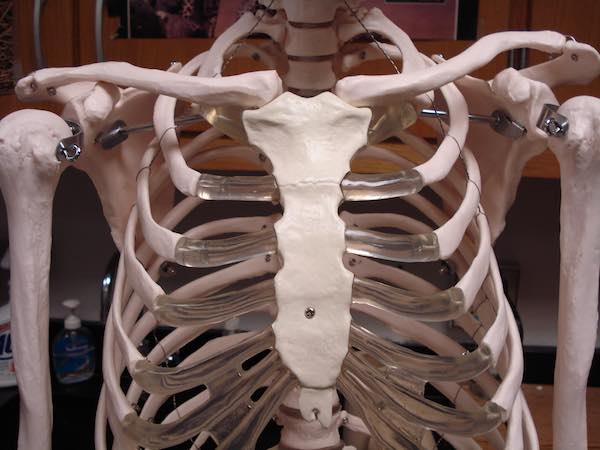
[Image above] Credit: biologycorner; Flickr CC BY-NC 2.0
When it comes to materials for biomedical implants, ceramics have something its materials brethren, metals and polymers, completely lack—bioactivity.
Sure, metals and polymers may have the strength and flexibility that ceramics can sometimes lack, but when it comes to the ability to bond to living tissues, it’s no contest.
Bioactivity is an important parameter for helping the body to rebuild—cells and tissues needs to be able to bond with an implant to allow repaired joints and bones to function like they once did. A bioinert material like metal doesn’t promote that bonding, preventing the body from being able to integrate with its new hardware.
Luckily for metal, however, the material’s not totally out of the implant game—a glass coating and a ceramic processing technique apparently can work wonders for an otherwise bioinert material.
“We developed a novel and facile approach to modify metallic surfaces with random and aligned bioactive phosphate glass fibers by electrophoretic deposition, a well known processing technique in ceramic processing,” Aldo Boccaccini, ACerS Fellow and professor of biomaterials and head of the Institute of Biomaterials at the Department of Materials Science and Engineering at the University of Erlangen-Nuremberg, Germany, explains via email.
Boccaccini is senior author of a recent ACS Applied Materials & Interfaces paper describing how the glass fiber coating may be able to improve the biocompatibility of metal implants, performed by a team of researchers from the Institute of Biomaterials at University of Erlangen-Nuremberg, Germany; the Department of Mechanical, Materials and Manufacturing Engineering at the University of Nottingham, U.K.; and the Key Laboratory for Space Bioscience and Biotechnology, School of Life Sciences and Northwestern Polytechnical University in Xi’an, China.
Electrophoretic deposition—which uses an electric field to control deposition of charged particles—is a low-cost processing method, performed at room temperature, that can easily be scaled-up. So “there are very good possibilities for the commercial exploitation of electrophoretic deposition-based coating techniques in the biomedical field” Boccaccini says.
And by tailoring the technique to form coatings of phosphate glass fibers embedded in a polymer that can be deposited on even irregular metal surfaces, the researchers are finding that those possibilities might include the ability to significantly enhance the biocompatibility of metal implants and promote healing through improved tissue-to-implant interfaces.
Using electrophoretic deposition, the scientists demonstrated that they can lay down layers of 1–2-mm-long phosphate glass fibers in a poly(acrylic acid) polymer solution. And by varying parameters of the process, the technique can control both coating thickness and fiber orientation, depositing the glass fibers in neat parallel rows.
Controlling fiber orientation is critical when it comes to implants. And it’s not just for a neat appearance—fiber orientation actually has a significant effect on how cells behave, impacting the shape of cells and how they differentiate, or change, into other specialized cell types—a factor that is critical to the body’s natural healing processes.
Plus, phosphate glass fibers already have a good track record for biocompatibility. In addition to providing both structural and biological benefits, the fibers are completely resorbable in the body as well—offering new possibilities for engineering more biologically friendly biomedical implants that can evolve along with the body’s natural healing processes.
The idea is that these EPD-deposited phosphate glass fiber coatings would provide an interface on the otherwise bioinert metal implant for the body’s own tissues to bond to—prompting critical initial growth and healing after the implant has been installed.
But it’s important to note that these interfacial coatings aren’t a permanent metal-masking solution, as the phosphate glass fibers are eventually resorbed by the body.
“The proposed biodegradable coating is thus mainly used to strengthen the link between bone tissue and the implant at the early stage of implantation,” Boccaccini explains.
Then, once the glass fibers resorb away, the bone’s healing processes with the new implant are well underway.
“It is anticipated that by this stage the implant would have made a good union with the surrounding hard tissue,” Boccaccini continues. “Having a polymer component present could also enable incorporation of other useful components—such as drugs, for example, to address infections, and even growth factors to stimulate bone growth.”
The team’s experiments so far, using human cells cultured in the lab, show that oriented glass fibers coatings can enhance and direct proliferation of bone-related precursor cells and enhance osteoblast activity, indicating that bone will be able to bond onto the surface.
These cells, called pre-osteoblast cells, eventually become osteoblasts. And because osteoblasts are the cells that help lay down bone tissue, these are precisely the ones you want to be active when it comes to healing bone.
The scientists are next measuring in vivo responses to the glass fiber coatings, examining the effect of different fiber compositions, which have different degradation rates, according to Boccaccini.
An added bonus is that the glass fiber coatings are completely customizable, affording possibilities of implants that are tailor-coated for patients’ individual healing needs.
“We can tailor the degradation rates for phosphate glass fibers, which is what makes them really unique and versatile materials,” Boccaccini writes. “The formulations that are proving to be highly cytocompatible would take approximately 9–12 months to resorb, or even longer if required (by simply tweaking the formulations).”
“The possibility of tuning the fiber composition as well as the versatility of the coating technique open interesting opportunities for the biofunctionalization of metallic implants, for example bone implants, in the future.”
The paper, published in ACS Applied Materials & Interfaces, is “Electric field-assisted orientation of short phosphate glass fibers on stainless steel for biomedical applications” (DOI: 10.1021/acsami.8b01378).
Want to read more articles like this? Subscribe to the Ceramic Tech Today newsletter to continue to receive the latest news in the ceramic and glass industry right in your inbox! Visit this link to get started.
Author
April Gocha
CTT Categories
- Biomaterials & Medical
- Glass
- Manufacturing
- Material Innovations
- Nanomaterials
Related Posts
Ohio Creativity Trail: Heisey Glass Museum
January 13, 2026


